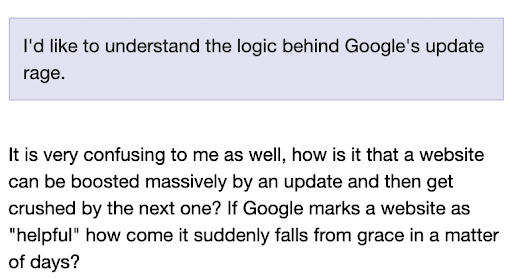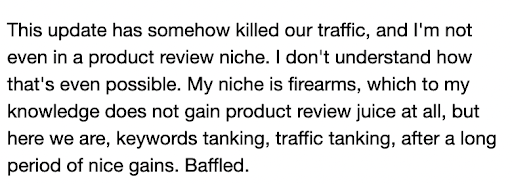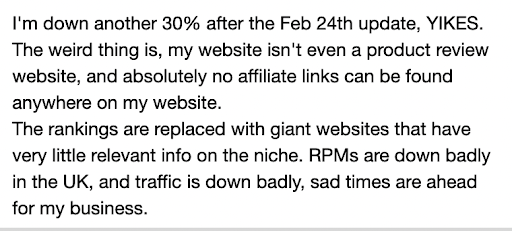Google’s product reviews updates: Boost your business with trustworthy feedback

On February 23, 2023, Google announced the rollout of its latest product reviews updates. This is the sixth iteration of Google’s latest guidelines for product review content.
Google made the official announcement via its Search Central Twitter account:
Today we released the February 2023 product reviews update, which applies to these languages globally: English, Spanish, German, French, Italian, Vietnamese, Indonesian, Russian, Dutch, Portuguese, Polish. It’ll take ~2 weeks to fully roll out.
In this post, you’ll find a complete breakdown of what this latest Product Reviews update – and the system as a whole – means for websites and local SEO strategy, including answers to questions such as:
- What does this update mean for existing product review content?
- Are only product review websites affected?
- What are the best practices to follow to stay ahead of this update?
- How can local enterprise brands gauge whether this update will impact their website traffic, and what can they do?
What is Google’s product reviews system?
As per the Google Search Central guidelines, “The product reviews system aims to better reward high-quality product reviews, which is content that provides insightful analysis and original research and is written by experts or enthusiasts who know the topic well.”
In other words, Google wants to reward high-quality reviews that are genuine, based on expert opinion or original research/enthusiasm in the niche the product belongs to. These reviews should demonstrate an in-depth understanding of the product so that consumers are given the most accurate information and not be misled.
Google’s opinion is that whether these reviews live on your website or third-party review websites, they subconsciously or directly inform your customer’s inclination to buy your products — so as a search engine, their job is to filter out spammy, low-quality, and downright misleading reviews.
Interestingly, a website doesn’t have to be a product review content website or even an affiliate website for the product reviews system and any product reviews update to apply.
Any website with a “substantial amount of product review content” will be subject to a page-wise or site-wise evaluation.
Here’s what Google had to say about it:
“The product reviews system primarily evaluates product review content on a page-level basis. However, for sites that have a substantial amount of product review content, any content within a site might be evaluated by the update.”
The precise percentage of content that needs to be product review content is not mentioned. Even if you have a few reviews on your website (which you ideally should), you must pay attention to this and previous product review updates.

What were the previous product review updates?
The previous five updates to the product reviews updates took place on:
- April 8, 2021, which introduced the concept of replacing “thin content that simply summarizes a bunch of products.”
- December 1, 2021
- March 23, 2022
- July 27, 2022
- September 20, 2022
Read more about the September 2022 update to understand what has changed since then.
Roger Montti of Search Engine Journal points out the significant replacement of “product reviews update” with “product reviews system” in the name of the Google documentation.
He observes that though this is not a core update, as with every algorithm, Google may not communicate periodic refreshes to this algorithm as standalone public updates. If notable changes are made to the product reviews system, Google announces these developments.
In other words, this update is major and is expected to impact many websites.
Who is impacted by Google’s product review system updates?
The first aspect to note is that this product reviews update, unlike previous updates, goes beyond English-language product reviews. It covers product review content in 11 languages.
Product review websites are an affected category. Websites that pump out myriad listicles of titles like “20 best phones in 2022” and partake in keyword stuffing are likely to get hit. But these websites are not the only ones that need to be wary.
Any website offering a service or product (basically, any e-commerce website or service website) will be impacted, especially if it has reviews in a language that is within the update’s scope.
Google cannot or doesn’t want to differentiate between a product review site and a service website. Thematically, both of them are likely to have reviews, so Google will scour through and assess them against the parameters of product review system updates on a page-to-page level.
For example, if you’re a marketing SaaS brand with a blog about the best customer data platform tools or a local enterprise brand covering the best Italian restaurants in your area — your page will likely be affected.
In all likelihood, even pages that are a part of blogs on websites that are not selling anything will be affected if they contain review content.
How do you know if you fall under any of these categories?
To determine if you fall under a category that may be impacted, consider the following:
- Is your website or any page on it about products or services, even if you are not selling those products or services? These could include product roundup pages and buying guides.
- Does it contain images, dimensions, or “how to use” tutorials about a product?
- Do you have quotes that assess the efficacy of a product or service?
Another way to look at this is how Google puts it. Are you:
- A blogger who provides independent opinions of products?
- A staff member at a news or publishing site who is writing about products?
- A staff member of a merchant providing comparisons with competing products?
Google will see all of these as indicators of product review content. E-commerce stores, e-commerce websites, and local enterprise brands fall squarely into the above categories.
How can you tell your site is affected by the product reviews update?
Apart from knowing if the update will hit you based on the content on your website, you can track your performance in Google Analytics or Search Console to find out for sure.
If you see changes after the roll-out and fall into the categories mentioned in the previous section, the update is probably causing changes in your website’s performance.
Google will not specify the percentage of queries or searches impacted by the update, so it’s recommended to err on the side of caution.
It’s also worth noting that, as is often the case with most updates, all websites are not hit simultaneously — some are hit later than others.
The best way to know if yours has already been hit is to evaluate your website analytics and see if there’s a slump in website traffic on pages that contain product review content.
How can you recover if impacted negatively by the product reviews update?
Google maintains that its product review updates are not a penalty. It’s an opportunity to rank by incorporating “insightful analysis and original research” on your website. Still, seeing your traffic plummet can be discouraging.
Google’s goal with these guidelines is to satisfy searcher’s queries with high-quality product reviews — and that’s a good goal to match up to as a website owner.
You want to give potential purchasers as much accurate information as possible about the product before they purchase it. This, in turn, makes your website stand out and become more trustworthy.
Google lists some best practices to achieve this goal. Some of these include:
- Clearly state why you are suitable for reviewing the product – demonstrate your knowledge and show you are an expert.
- Explaining how the product is better than competing products and a comparison of similar products.
- Going over the product’s drawbacks based on actual usage or original research and addressing any issues.
- Incorporating other valuable resources from your site or other sites to help readers make a purchase decision.
- Providing evidence related to why you are recommending one product over another.
While these best practices by Google can help offset the adverse impacts of the Product Review update, there are other tricks, too.
SEO best practices to follow after this update
When you use images in your review content, add alt-text to all the images. This helps Google identify what the image is about.
Avoid using stock photos because then your content will not be unique. Include original images of product testing as much as possible.
If you cannot click original photos, you can edit stock photos to include a differentiating factor. This could be a different background, unique labeling, and more. Remember to reverse-search your image on Google when you edit stock photos to verify its uniqueness.
Because images are not the only aspect of a high-quality review when including user reviews on the website, you can show authenticity by linking to the reviewer’s LinkedIn or website. This provides an additional source Google can use to verify whether the reviews are authentic.
Another tip to establish authenticity is to link your social media to the website to show that you are an authority in the niche. This indicates your reviews are not a product of content spinning.
If you are reviewing the product, lay down the parameters you used to review and the evaluation method. This shows Google that your reviews are credible and original.
Focus on providing unique perspectives from experts or genuine users of the product. Google will recognize when reviews are false or taken from top-ranking content.
User-generated content is your easiest bet, so incentivize customers or target product users to review your products impartially.
How are other businesses/marketers reacting to this update?
Here are some reactions to this February 2023 update to the Google Product Reviews System:
Some marketers are hailing this as the final blow to affiliate websites that produce numerous product roundup blogs littered with affiliate links and keywords without any useful content.

Others are asking questions related to the nitty-gritty of Google’s guidance.
When you want product review content but don’t have the expertise or hands-on experience with the products, it’s best to crowdsource reviews from actual users so that your information is factual and original.

Commenters on Webmaster World are in a world of confusion:

It is important to note that even if you are not a product review website if you have keywords such as “best firearms” or anything indicating an assessment of a product, you could be impacted:

The absence of affiliate links doesn’t mean your website doesn’t have product review content:

High-quality product reviews: The ultimate test
Think of it this way – if the review makes you feel like you could recommend the product to someone you know, either because it has in-depth analysis, expert knowledge, or authoritative insight, then you are good to go. If you are manufacturing any part of the process, you must be wary.
You can also follow Google’s general content guidelines to stay in the green with the recent product reviews update and future content-related updates to come.
More helpful resources:




